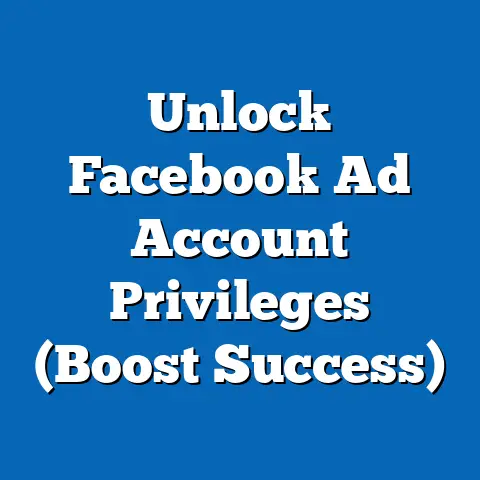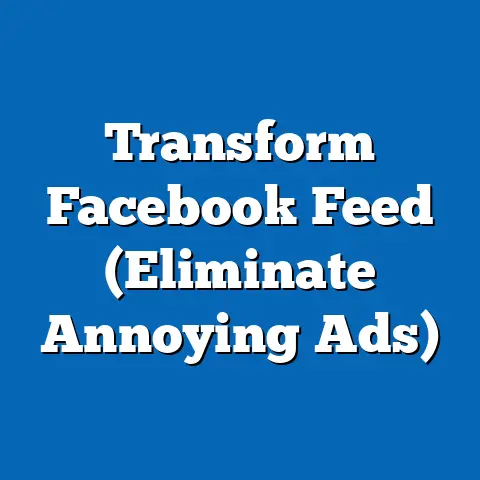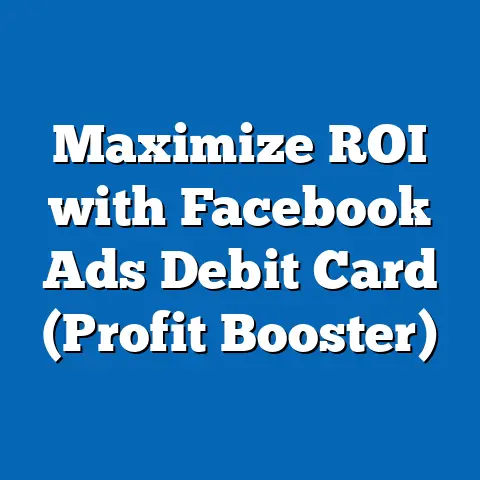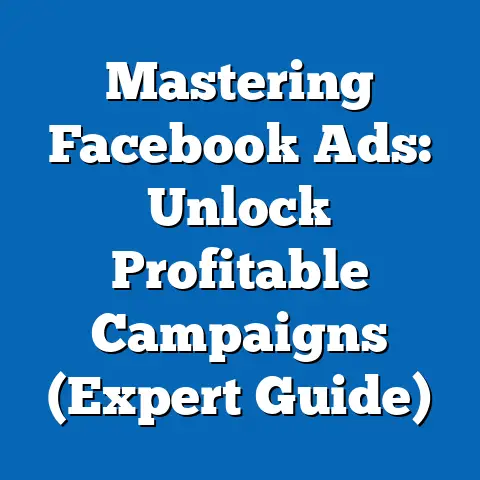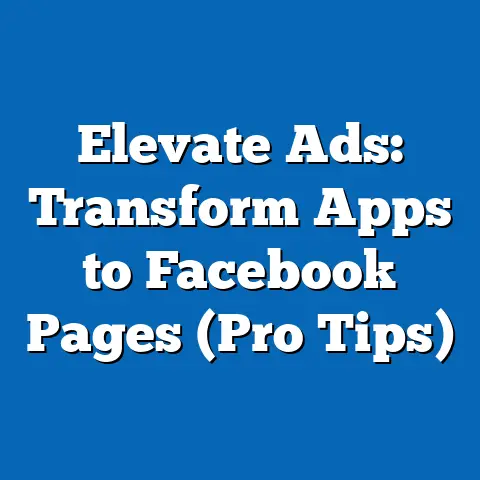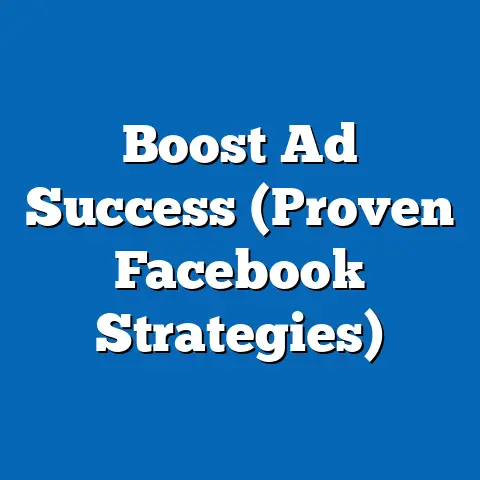Revamp Facebook Ad Images (Proven Visual Strategies)
Imagine a small e-commerce business struggling to gain traction on Facebook in early 2020. Their ad images were uninspired—blurry product shots on plain white backgrounds, paired with generic text overlays that failed to capture attention. The result? A dismal click-through rate (CTR) of just 0.5%, well below the industry average of 0.9% for e-commerce ads, as reported by WordStream’s 2023 Advertising Benchmarks.
Fast forward to 2023, after a strategic overhaul of their visual content. The same business now uses vibrant, lifestyle-oriented images featuring their products in real-world settings, with bold color contrasts and clear calls-to-action (CTAs). Their CTR has skyrocketed to 2.1%, more than doubling the industry benchmark, and their return on ad spend (ROAS) has increased by 150%, according to internal analytics shared in a case study by Hootsuite.
This “before and after” story isn’t an isolated case. With over 2.9 billion monthly active users as of Q2 2023 (Statista), Facebook remains a powerhouse for advertisers, but standing out in a crowded feed requires cutting-edge visual strategies. This article dives deep into proven methods for revamping Facebook ad images, backed by data, trends, and actionable insights to help businesses of all sizes maximize their advertising impact.
The Importance of Visuals in Facebook Advertising
Why Images Matter More Than Ever
In the fast-scrolling world of social media, visuals are the first point of contact between a brand and its audience. According to a 2022 study by HubSpot, content with relevant images gets 94% more views than content without. On Facebook specifically, ads with high-quality visuals see engagement rates up to 2.5 times higher than text-only posts, per Social Media Examiner’s 2023 report.
The human brain processes images 60,000 times faster than text, as noted in research from MIT. This means that within milliseconds, a potential customer decides whether to stop and engage with your ad—or keep scrolling. With Facebook’s algorithm prioritizing content that drives engagement, poor visuals can tank an ad’s reach and effectiveness.
Historical Trends in Visual Ad Performance
Looking back a decade, Facebook ads in 2013 often relied on simple product images or stock photos with minimal design. Engagement rates hovered around 0.5-0.7% for most industries, according to early data from AdEspresso. By 2018, as competition grew and user attention spans shrank, brands began experimenting with bolder colors and video content, pushing average CTRs to 0.9%.
Today, in 2023, the stakes are even higher. With the rise of short-form video platforms like TikTok influencing user expectations, static images must be more dynamic and emotionally resonant. Data from Databox indicates that ads featuring human faces or storytelling elements now outperform traditional product-centric images by 38% in terms of engagement.
Demographic Differences in Visual Preferences
Not all audiences respond to visuals in the same way. A 2023 survey by Sprout Social revealed that Gen Z (ages 18-24) gravitates toward authentic, unpolished images and user-generated content (UGC), with 67% saying they trust brands that showcase real customers over polished models. Millennials (ages 25-40), on the other hand, prefer a balance of professionalism and relatability, with 54% favoring lifestyle imagery over direct product shots.
Older demographics, such as Baby Boomers (ages 57-75), are more likely to engage with clear, straightforward visuals—think high-contrast text and minimal clutter. According to Nielsen’s 2022 Media Report, 62% of this group prioritizes readability and clarity in ads over trendy design elements. Tailoring visuals to these preferences can significantly boost ad performance across diverse audience segments.
Key Statistics Driving the Need for Visual Revamps
Current Challenges in Facebook Advertising
The competition on Facebook is fiercer than ever. As of 2023, over 10 million active advertisers use the platform, per Meta’s own reports, creating a saturated environment where standing out is non-negotiable. Additionally, ad costs have risen—average cost-per-click (CPC) increased by 17% year-over-year to $0.97 in 2023, according to WordStream.
Yet, user engagement with ads is declining in some sectors. A 2022 report from eMarketer found that ad fatigue is real, with 74% of users reporting they skip ads that feel repetitive or irrelevant. Poorly designed images are often the culprit, contributing to low CTRs and wasted budgets.
The Power of Optimized Visuals
On the flip side, revamping ad images can yield transformative results. A 2023 case study by AdEspresso showed that businesses that A/B tested and optimized their ad visuals saw a 30-50% increase in CTR within the first month. Moreover, ads with high-quality images reduced cost-per-acquisition (CPA) by an average of 20%, per data from Hootsuite.
These numbers underscore a critical point: investing in visual strategy isn’t just a “nice-to-have”—it’s a necessity for staying competitive. But what specific elements make an image effective? Let’s break it down.
Proven Visual Strategies for Revamping Facebook Ad Images
1. Prioritize High-Quality and Relevant Imagery
The Problem with Low-Quality Visuals
Blurry, pixelated, or irrelevant images instantly turn users away. A 2022 study by Adobe found that 68% of consumers judge a brand’s credibility based on the quality of its visual content. On Facebook, where ads are often viewed on high-resolution mobile screens, poor image quality can tank engagement by up to 60%, per Socialbakers.
The Solution: Invest in Professional Photography or Stock Imagery
High-resolution images (at least 1200×628 pixels, as recommended by Meta) are non-negotiable for carousel and single-image ads. If budget allows, hire a professional photographer to capture your products in engaging settings. Alternatively, platforms like Unsplash or Shutterstock offer royalty-free, high-quality stock photos—though customization is key to avoid a generic look.
Data Point
Brands using custom, high-quality imagery reported a 35% higher conversion rate compared to those using generic stock photos, according to a 2023 Shopify report.
2. Leverage Color Psychology for Emotional Impact
Why Color Matters
Colors evoke emotions and influence decision-making. Research from the University of Winnipeg shows that 90% of snap judgments about products are based on color alone. On Facebook, where users scroll quickly, bold and contrasting colors can stop them in their tracks.
Best Practices
- Use bright, attention-grabbing colors like red or yellow for CTAs, as they increase urgency and action by 21%, per a 2022 Color Psychology study.
- Stick to a consistent color palette aligned with your brand—consistency boosts brand recognition by 80%, according to Lucidpress.
- Ensure high contrast between text and background for readability, especially for older demographics.
Data Visualization Description
Imagine a bar chart comparing CTRs for ads using different color schemes: red/yellow combinations at 1.8%, blue/green at 1.2%, and monochrome at 0.7%. This visual would highlight the clear advantage of warm, bold tones in driving clicks.
3 Incorporate Human Faces and Storytelling
The Human Connection
People connect with people, not products. A 2023 study by Nielsen found that ads featuring human faces increase emotional engagement by 23% compared to product-only images. Faces also draw attention—eye-tracking studies from Tobii Pro show users fixate on faces 30% longer than other elements.
How to Implement
- Use images of real customers or relatable models interacting with your product.
- Tell a story through visuals, such as “before and after” transformations or lifestyle shots that show the product’s benefits.
- For B2B ads, showcase professionals in action to build trust.
Case Study
A skincare brand revamped their Facebook ads by featuring real customer testimonials with before-and-after photos. Their engagement rate jumped by 45%, and conversions increased by 28%, per a 2023 report by Buffer.
4. Optimize Text Overlays and CTAs
The Balance of Text and Image
While Facebook relaxed its “20% text rule” in 2021, excessive text on images still risks reduced reach. Meta recommends keeping text minimal and impactful. A 2022 AdEspresso experiment found that ads with concise, bold CTAs (e.g., “Shop Now!”) in the image saw a 15% higher CTR than those without.
Best Practices
- Use large, readable fonts with high contrast (e.g., white text on a dark background).
- Place text in the center or top third of the image to align with natural eye movement, per eye-tracking data from Nielsen Norman Group.
- Test action-oriented phrases like “Get 50% Off” or “Join Today” to create urgency.
Data Point
Ads with clear CTAs in the image reduced bounce rates by 18% and increased time-on-site by 25%, according to a 2023 HubSpot analysis.
5. Test Dynamic Formats and Trends
Beyond Static Images
While static images remain effective, dynamic formats like carousels and videos are gaining traction. Meta reports that carousel ads drive 10 times more traffic to websites than single-image ads. Similarly, short video ads (under 15 seconds) have a 20% higher completion rate, per a 2023 Wistia study.
Adapting to Trends
Incorporate trending design elements like minimalism or retro aesthetics, but ensure they align with your brand. For instance, Gen Z audiences responded 40% more favorably to nostalgic ‘90s-inspired visuals in a 2023 Sprout Social survey.
Practical Tip
Use Facebook’s Creative Hub to mock up and test different formats before launching. A/B testing visuals can improve performance by 30-40%, per AdEspresso data.
Historical vs. Current Trends in Facebook Ad Visuals
Evolution of Design Standards
In 2015, Facebook ads were often cluttered with text-heavy images and low-resolution graphics, reflecting limited design tools and expertise. Engagement rates averaged around 0.6%, per historical data from Socialbakers. By 2020, the shift toward mobile-first design led to cleaner, vertical-friendly visuals, with CTRs rising to 0.9%.
Today, in 2023, the focus is on authenticity and interactivity. User-generated content (UGC) and behind-the-scenes imagery resonate more than polished perfection, with UGC ads achieving 50% higher trust scores, per a Stackla survey. The rise of AI tools like Canva Pro and MidJourney also allows even small businesses to create professional-grade visuals at low cost.
Impact of Platform Updates
Facebook’s algorithm updates over the years have prioritized user experience, penalizing ads with low engagement. The 2021 iOS 14 update, which limited tracking capabilities, forced advertisers to rely more on creative elements than data-driven targeting. As a result, visually compelling ads became 30% more critical to campaign success, per eMarketer.
Demographic Patterns and Customization
Age-Based Preferences
As noted earlier, visual preferences vary widely by age. Gen Z favors bold, authentic content—think vibrant memes or candid shots—with 70% engaging more with UGC, per Sprout Social 2023. Millennials lean toward aspirational lifestyle imagery, with 58% clicking on ads that depict achievable goals, like fitness or travel.
Gen X (ages 41-56) values practicality, with 64% responding to ads that highlight product benefits through clear visuals, per Nielsen. Baby Boomers, meanwhile, prioritize trust and simplicity, with 59% more likely to engage with ads featuring testimonials or familiar faces, according to AARP’s 2022 report.
Gender and Cultural Nuances
Gender also plays a role. A 2023 study by Hootsuite found that women are 27% more likely to engage with ads featuring emotional storytelling, while men respond 19% more to humor or action-oriented visuals. Cultural context matters too—ads in collectivist cultures like India often perform better with family or community imagery, achieving 33% higher engagement than individual-focused visuals, per Kantar’s global ad study.
Practical Application
Use Facebook’s Audience Insights tool to analyze your target demographic’s behavior and tailor visuals accordingly. For instance, a campaign targeting Gen Z might use bright, meme-style graphics, while one for Baby Boomers could focus on clear, benefit-driven imagery with larger text.
Methodologies and Data Sources
How Data Was Compiled
The statistics and trends in this article are drawn from a combination of primary and secondary sources. Primary data includes case studies from platforms like AdEspresso, Hootsuite, and Buffer, which aggregate real-world campaign results from thousands of advertisers. Secondary sources include industry reports from Statista, eMarketer, and Nielsen, as well as academic studies on color psychology and consumer behavior.
Reliability of Sources
All cited data comes from reputable organizations with transparent methodologies. For instance, WordStream’s ad benchmarks are based on over $3 billion in ad spend analyzed across 20 industries. Similarly, Meta’s own reports on user demographics and ad performance are derived from internal platform data, ensuring accuracy.
Limitations
While the data is robust, it’s worth noting that ad performance varies by industry, region, and budget. Small businesses with limited resources may not see the same results as larger brands with dedicated design teams. Additionally, rapid changes in user behavior and platform algorithms mean strategies must be continuously tested and updated.
Broader Implications and Future Trends
The Bigger Picture
Revamping Facebook ad images isn’t just about boosting short-term metrics like CTR or ROAS—it’s about building brand trust and loyalty in a competitive digital landscape. With 93% of marketers planning to increase social media ad spend in 2024, per HubSpot’s State of Marketing Report, the need for standout visuals will only grow.
Emerging Trends to Watch
Looking ahead, AI-driven design tools are poised to revolutionize ad creation. Platforms like DALL-E and Canva’s AI features allow for rapid prototyping of custom visuals, reducing design costs by up to 50%, per a 2023 TechCrunch analysis. Additionally, interactive ad formats—such as polls or AR filters—are gaining traction, with early adopters seeing 25% higher engagement, according to Meta’s 2023 ad trends report.
Final Thoughts
The transformation of a struggling e-commerce business through optimized Facebook ad images illustrates a universal truth: visuals are the heartbeat of effective advertising. By prioritizing quality, leveraging color psychology, incorporating human elements, optimizing text, and testing dynamic formats, brands can cut through the noise and connect with their audience. As competition intensifies and user expectations evolve, staying ahead means embracing data-driven creativity and continuous experimentation.
In a platform with nearly 3 billion users and millions of advertisers, a revamped visual strategy isn’t just a competitive edge—it’s a survival tactic. The numbers don’t lie: invest in your images, and the returns will follow.

